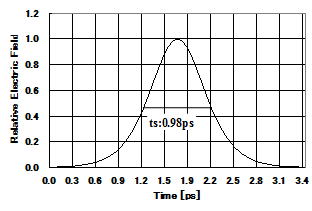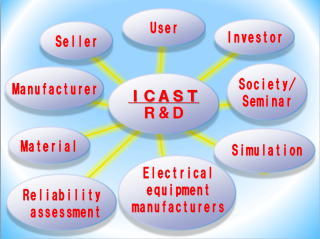|
|
Innovation for Circuit And System Technologies,
Innovation of Circuit And System Technologies.
ICAST,Inc. information |
 |
ICAST will provide the next solution from the ground up to transform a
variety of electrical circuits and electrical products by a unified new
theory about the behavior of electromagnetic waves in the circuit, that
theory named "solitary electromagnetic wave (SEMW) theory".
◆A elucidation and theorization of the electromagnetic wave generation mechanism in circuits.
◆Fundamental solution of Electromagnetic noise problems (EMC/EMI problems).
◆Significant performance improvement of digital equipments.
◆Brought to the circuit design : a significant simplification, into logic, and improve flexibility.
◆Significant reduction of parts used.
◆Reduction in total cost of electrical products.
◆Research and development of products utilizing "solitary electromagnetic wave theory".
◆Joint development of new products, assistance, consulting.
◆To lecture the Foundations and Applications of "solitary electromagnetic
wave theory". |
| Our new scientific article has been released. |
| SEMW theory (solitary electromagnetic wave theory) |


|
A new theory developed by ICAST to elucidate the mechanism of occurrence
and behavior of electromagnetic waves in the electrical circuit.
To illustrate the behavior of the electromagnetic wave generated in the
electric circuit, this theory does not use an approximate calculation,
such as by using conventional methods, such as Fourier transform or equivalent
circuit.
This theory has been described it in more substantive based on the "non-linear theory" and "Electrical Engineering" and "electromagnetism", using the concept of "soliton" is completely single solitary wave.
This theory is being proven to be a significant part by the Measured data
of experiments, simulations by SPICE, and development of new calculations
which ICAST has made. |
| LILL (low impedance lossy line) |


On-board LILL

|
LILL is one of the technology that has been developed based on SEMW theory to control the electromagnetic wave in electrical circuits.
LILL has the function of reflecting the electromagnetic waves, and contributes
to, such as suppression of electromagnetic noise on the power supply side
and faster circuit mainly.
An Electromagnetic wave necessary for the excitation of voltage of the
circuit is generated by a switching.
And voltage is excited completely by an electromagnetic wave is transmitted
to the signal side from the switch completely.
But Half of the electromagnetic waves generated by the switching is propagated
to the power supply side once, and reflected back on the power, the voltage
is completely excited for the first time it is transferred to the signal
side, the circuit starts to operate.
According to the calculation based on this theory, this time difference,
the half electromagnetic wave is reflected back at power supply after propagating
power supply side, coincides with the actual time difference until the
excitation voltage from the switching.
Accordingly, if you build a structure that reflects the electromagnetic
waves right next to the switch of power supply side, you will reduce this
time difference as possible, the required voltage will be excited after
the switching instant.
We call this structure reflects electromagnetic waves "LILL".
There are three types of LILL is in that we developed, that is to say, type to be installed as a component on the board (on-board type), type to be built directly into the board (built-in type), type to be built directly into the LSI chip (on-chip type). |
| MILL (matched impedance lossy line) |


SEMW on the MILL
|
MILL is one of the technology that has been developed based on SEMW theory to control the electromagnetic wave in electrical circuits.
MILL has the function to absorb electromagnetic waves, mainly contributes to
such as the suppression of the circuit's malfunction and electromagnetic
noise in signal side.
By the switching of hundreds of millions of LSI, huge number of SEMW is
generated.
These SEMW continues to propagate everywhere in the circuit, Until completely consumed as the energy of the excitation voltage.
In the process, several SEMW may leak into adjacent lines that are not directly connected (cross talk), or may leak to the outside of equipments, devices, or circuits.
The structure while absorbing these "noisy" SEMW, to supply the
energy required for the excitation voltage circuit is called "MILL" to us.
Accordingly, if you build a structure of MILL right next to the switch of signal side, you will achieve a more complete suppression of electromagnetic wave leakage.
There are three types of MILL is in that we developed, that is to say, type to be installed as a component
on the board (on-board type), type to be built directly into the board (built-in type), type to be built directly into the LSI chip (on-chip type). |
| Domain of applicability of the theory and technology of ICAST |
| Wanted cooperating companies |
 |
We are looking for business cooperation, or companies and institutions
to introduce our company cooperation.
I hope if there is anything that you come to mind about them, we want to
hear from here.
Thank you kindly. |
"Solitary Electromagnetic Wave Theory with Its Development Process
and Application"
Hirokazu Tohya, ICAST, Inc., Hachioji City, Tokyo, Japan.Noritaka Toya, ICAST, Inc., Hachioji City, Tokyo, Japan.
Physics Journal, Vol. 2, No. 3, May 2016, Pub. Date: Jan. 25, 2016
Public Science Framework owned by AIS
Hirokazu Tohya, Toshiki Shimasaki, Kengo Mori, Takuya Osato, Nobuo Kuwabara,
and Hidenori Muramatsu, “Simple and Convenient EMI Managenant Method for
Modules of IT Equipment”, IEEE, EMC EUROPE 2012, P-35:1, 2012.
遠矢弘和、遠矢紀尚, “電磁干渉問題の解決と高速化に向けての検討”, エレクトロニクス実装学会, 超高速高周波エレクトロニクス実装研究会/平成24年度第1回公開研究会論文集, Vol. 12, No.1, pp. 7– 12, 2012.
Hirokazu Tohya and Noritaka Toya, “Solitary Electromagnetic Waves Generated
by the Switching Mode Circuit”, INTECH open access publisher, Behaviour
of Electromagnetic Waves in Different Media and Structures, pp.249-274,
2011.
free delivery start from 7/7/2011at INTEC (the page of the article is here)
遠矢弘和, 遠矢紀尚, “スイッチングモード回路における電磁干渉の抑圧技術”, 電気学会, 電子回路研究会資料, ECT-11-039, pp.23-28, 2011.
遠矢弘和, 遠矢紀尚, “新しい孤立電磁波理論に基づくディジタルシステムの性能向上技術”, 第25回エレクトロニクス実装学会春季講演大会, 9A-05 依頼講演, pp.79-82, 2011.
Hirokazu Tohya and Noritaka Toya, “Novel Design Concept and technologies of the Switching Mode Circuit based on the Electromagnetic Wave theory and the Nonlinear Undulation theory”. IEEE, TENCON2010, pp.1135-1140, 2010.
Hirokazu Tohya, Noritaka Toya, “Novel Design Concept and Technology for the Switching Mode Circuit based on the Electromagnetic Wave theory and the Nonlinear Undulation theory, ” IEEE, ISCIT 2010, pp. 1097-1102.
遠矢弘和, 遠矢紀尚, “スイッチングモード回路の性能向上技術”, 電気学会, 電子回路研究会資料, ECT-10-88, pp.19-24, 2010.
Hirokazu Tohya, Noritaka Toya, “A Novel Decoupling Component for the Power Distribution Network”, IEEE, ICGCS 2010, pp.479-484, 2010.
遠矢弘和、遠矢紀尚, “スイッチングモード回路の性能向上技術についての一考察”, エレクトロニクス実装学会 超高速高周波エレクトロニクス実装研究会/平成22年度第2回公開研究会論文集, Vol.10, No.2, pp.23-28, 2010.
遠矢弘和、遠矢紀尚, “スイッチングモード回路におけるEMI抑圧技術の紹介”, エレクトロニクス実装学会, 超高速高周波エレクトロニクス実装研究会/平成22年度第1回公開研究会論文集, Vol. 10, No.1, pp. 35– 40, 2010.
遠矢弘和、遠矢紀尚, “スイッチングモード回路における電磁波の挙動についての一考察”, エレクトロニクス実装学会, 超高速高周波エレクトロニクス実装研究会/平成22年度第1回公開研究会論文集, Vol. 10, No.1, pp. 29– 34, 2010.
遠矢弘和, 遠矢紀尚, “オンチップインバータが励起する孤立波の電源線路および信号線路上での挙動についての一考察”, 電気学会, 電子回路研究会資料ECT-09-54, pp.7-12, 2009.
大熊繁, 遠矢弘和監修, “自動車のEMC対策”pp. 9-63, トリケップス, 2008.
遠矢弘和, “半導体LSIの配線(インターコネクト)設計の現状と新技術の提案”, 崇城大学 エネルギーエレクトロニクス研究所, E.E.研究所報告, Vol.13, No.1, pp.6- 13, 2007.
Hirokazu Tohya, Noritaka Toya, “A Novel Design Methodology of the On-Chip Power Distribution Network Enhancing the Performance and Suppressing EMI of the SoC”, IEEE, ISCAS 2007, pp. 889- 892, 2007.
遠矢弘和, 遠矢紀尚, “SoCの性能とEMCを大きく改善するオンチップ電源分配回路の新しい設計法”, 電子情報通信学会, 信学技報EE2007-20, pp. 73-78, 2007.
Hirokazu Tohya and Noritaka Toya, "DESIGN METHODOLOGY OF ON-CHIP POWER DISTRIBUTION NETWORK" IEEE, Fifth IEEE Dallas Circuit and System Workshop, pp.79-82, 2006.
Hirokazu Tohya and Noritaka Toya, “A Novel On-Chip Power Distribution Network Circuit Technology being able to actualize High-speed Signal Transmission and reduce EMI”, EIC/ KEES, 2006 Korea-Japan Joint Conference on AP/EMCJ/EMT, pp. 205- 208, 2006.
遠矢弘和, “半導体LSI用の新しい電源分配回路”, 電子情報通信学会, 信学技報EMCJ2006-41, pp.29-734, 2006.
|
・inquiries form
・TEL 042-683-0498 (International: +81-42-683-0498)
・FAX 042-683-0498 (International: +81-42-683-0498)
・E-MAIL postmaster@icastech.jp
・1-26-11 kinugaoka, Hachioji-shi, Tokyo 192-0912, Japan
ICAST,Inc.
Hirokazu Tohya, PhD. C.E.O. President |
|
|


